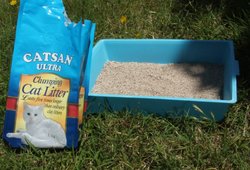

Custom Search
|
 A packet of clumping cat litter & a litter box
A packet of clumping cat litter & a litter boxCat litter is one of any of a number of materials used in litter boxes to absorb moisture from cat feces and urine, which reduces foul odors such as ammonia and renders them more tolerable within human dwellings.
Several kinds of cat litter are commercially available, enabling consumers to decide which factors are most important. Some cat owners are concerned about litter being tracked throughout the house, while others may look for litters that are biodegradable. Absorbency and odor control are other considerations.
One of the first commercially available cat litters was Kitty Litter, invented in 1947 and marketed by Ed Lowe. This was the first use of clay as an absorbent; prior to this time sand had been used in litter boxes instead. The new clay litter was more absorbent than sand, and its larger grain made it less likely to be tracked from the litter box.
Clumping litters were first developed in 1984 by biochemist Thomas Nelson. Most are made from granulated bentonite clay which clumps together when wet and form a solid mass separate from the other litter in the box. This solid clumped material can then be disposed of without changing the entire contents of the litter box often. However the entire contents should be changed on a regular basis to prevent buildup of bacteria, every four to six weeks is recommended. At the same time, the litter box itself should be disinfected. Approximately 60% of the cat litter market consists of clumping litter.
Some claim that clumping litters can be harmful to pets because if it is ingested or inhaled, it swells and solidifies inside them. For the same reason, it is not recommended to flush clumping litters down the toilet.
Silica gel litter, a porous granular form of sodium silicate, has the highest absorbancy of any litter, and has excellent moisture and odor control. Opinion about this type of cat litter is sharply divided. Some praise its absorbency while others deplore the fact that it gives no warning when it is exhausted and the next cat to use the litter tray will leave a urine puddle at the bottom of the pan. It also tends to be extremely lightweight, as opposed to the heavier clay. Silica gel litter is shaped into irregular lumps (which some cats abhor) or into small beads that tend to roll under pieces of furniture.
Biodegradable litter materials are pellets made of recycled paper, wood shavings (primarily pine), wood, corn cobs, dried orange peel, or wheat bran. Some pet owners prefer these litters due to their (perceived) friendliness to the environment; others are attracted by the flushability of the litter. They tend to be more expensive than traditional clay litters, so cost is not a positive factor in their selection. However, most of these forms of litter are recycled from human usage and are thus re-using a waste product as opposed to drawing clay from litter mines.
Although most dog-owners housebreak their pets, enough people train their dogs to use litter boxes that the Ralston Purina Company manufactures a dog litter under the brand name Secondnature, which generates revenues of approximately ten million dollars a year.